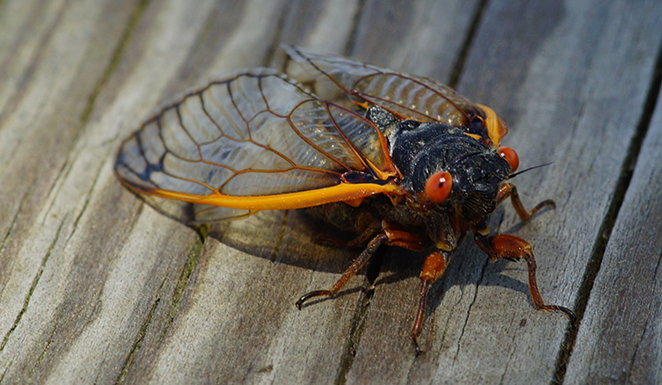What is a cicada?
According to Merriam-Webster, they are “any of a family (Cicadidae) of homopterous insects which have a stout body, wide blunt head, and large transparent wings and the males of which produce a loud buzzing noise usually by stridulation.” Basically, they’re those loud black insects with transparent orange wings and red eyeballs that pop out of the ground every 17 years.
Cicadas emerge as little teenagers (nymphs), shed their exoskeletons (the creepy brown cicada-shaped shells you see on plants and in the dirt), and then eat, mate and lay eggs in trees. Once the eggs hatch, they fall to the ground and the baby cicadas bury themselves in the earth to feed on roots until they emerge from the depths in 17 years and do it all again.
What is Brood X? And why does everyone keep talking about it?
Brood X (as in the Roman numeral for “10”) is the largest of all the 17-year cicada broods. We last saw Brood X, also known as Magicicada septendecim and “Pharaoh cicada,” in 2004.
How many cicadas are in Brood X?
“In South and Southwest Ohio, we are probably expecting in the billions,” says Gene Kritsky, Ph.D., the dean of behavioral and natural sciences at Mount St. Joseph University.
When will they be here?
Cicadas start burrow out of the ground when “the soil 8 inches beneath the ground reaches 64 degrees Fahrenheit,” says cicadamania.com. That means May and June, most likely, depending on the weather.
Where will they be located?
Cicadas in Brood X will be present in 15 states, including in cities like Cincinnati, Indianapolis, Louisville, Lexington, Columbus and Dayton.
What do they eat?
Cicadas don’t actually eat. They suck up juice, aka xylem, from plants (remember phloem and xylem from biology class?), which is where the nutrients are.
Do cicadas bite?
Cicadas aren’t dangerous to humans, but they are loud and annoying. Pest control company Orkin says, “Adult cicadas do not bite humans unless they are allowed to remain on someone long enough to mistake a part of the human body for a part of a plant.” So avoid mimicking a plant while the cicadas are here.
Why are they so loud?
That blaring chirping motor sound they make? That’s the males’ song. Male cicadas vibrate their “tymbals” — little membranes — to attract mates, but they also hum when they’re afraid, establishing territory or when they’ve found a girlfriend. Multiple males also will sing all at once in a “chorus” to attract more females.
Can you deter them?
You cannot stop cicadas from emerging. They are inevitable. But you can wear a hat — or a WalkingPod Mesh from local company Under the Weather — to prevent them from dropping into your hair or peeing on you. Yes, cicadas do let out little wee-wees of xylem.






